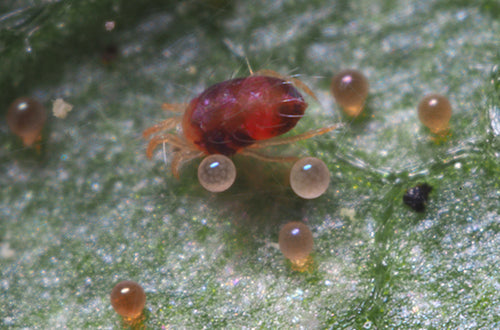Combating spider mites or spider mites on your vegetable garden plants
Introduction to spider mite control
Spider mites are a garden pest that can make life difficult for a large number of your plants. Spider mites can be found on your tomatoes, eggplants , potatoes , vines such as melons, cucumbers , and other crops. Once you have an infestation, you will find spider mites everywhere on your plant. It is therefore important to tackle spider mites before your plants suffer permanent damage. Let’s take a look at the preventative tips, control, and treatment of spider mites. Spider mite
Spider miteWhat is a spider mite?
Spider mites belong to the family of Acari (mites) Tetranychidae, which includes about 1,200 species. They usually live on the underside of the leaves of your plants, where they make their protective silk spider webs. They can cause damage by piercing the plant cells to feed. Spider mites are known to feed on several hundred plant species. In our vegetable garden, mainly on our tomatoes, eggplants , potatoes , climbing plants such as melons and cucumbers . Spider mites are less than 1 mm in size and can come in a variety of colors. They lay small, spherical, initially transparent eggs. Many species build their silken webs to help protect the colony from predators. The "spider" part of their common name comes from these webs they build. Warm, dry conditions are the right conditions for spider mites. Under optimal conditions (around 27°C) the two-spotted spider mite can hatch in just 3 days and become sexually mature in just 5 days. A female can lay up to 20 eggs per day and lives for 2 to 4 weeks and can lay hundreds of eggs in this way. This makes them very difficult to control. What is a spider mite?
What is a spider mite?How to recognize spider mites?
A plant that is infested with spider mites will look weak and unhealthy and will have a dusty appearance on the underside of the leaves. If you look closely at the underside of the leaf, you will be able to see that the dust is actually moving and that you are dealing with spider mites. The plant may also have some webbing at the base or on the branches of the plant. You cannot see the details of spider mites very well with the naked eye, but with a simple magnifying glass you can see the details better. A red spider mite is completely red. There are also spider mites, such as the two-spotted spider mite, that are partially red. Red spider mites are completely red. Shaking a few of them off onto a piece of white paper will help you distinguish the colors. How to recognize spider mites?
How to recognize spider mites?How to control spider mites and treat your plant?
How to prevent spider mites?
Try to grow as many different vegetables as possible in your vegetable garden. This way you can not only harvest tasty vegetables at different times, but you also make it harder for spider mites to find preferred plants and most importantly: you also attract useful insects. These useful insects are often their natural enemies. Using these natural enemies is the best way to combat spider mites ecologically . Lacewings are usually used, but predatory mites can also be used. You can work preventatively and release the beneficial insects in advance. You can also sow flowers in your garden and increase the biodiversity in your vegetable garden. The best predatory mite to work preventively is soni-mite . This predatory mite has no specific preference for temperature and already works at low humidity. Soni predatory mites are supplied in breeding bags with a hook. They offer 5 weeks of protection and sprout automatically. Look carefully at the product description for guidelines regarding application. Combat harmful mites with Soni-mite 250 breeding bags
Combat harmful mites with Soni-mite 250 breeding bagsHow to combat spider mites?
You can try to combat spider mites naturally with an infusion or slurry of nettles , but you have to spray it very regularly and if the population is too large or too deeply embedded, the slurry will hardly work. There are no acaricides (= insecticide) for private individuals that work against spider mites. The best remedy is therefore to make sure that you do not get them visiting you. Try to keep your plants healthy and the environment free of dust and waste to keep spider mites away. Also make sure that the plants have enough water. The water will help to keep spider mites away, because they prefer a very dry environment. You can use predatory mites both preventively and curatively. It is important that you look carefully at the product description to see which infestation you have and which environmental conditions you need to meet to obtain an optimal result. For example, a phyto predatory mite eats about 20 eggs or about 5 adult greenhouse spider mites every day. Forni-mite also eats other spider mites, does not need good humidity, works well at temperatures above 30°c and is therefore a good addition to phyto-mite. Both predatory mites can also be used in the vineyard.Finally
As we always try to strive for, a vegetable garden rich in biodiversity is the best remedy against harmful insects such as spider mites. Certain plants or shrubs attract ladybugs such as garlic, parsley, marigolds , coriander, dill , marigold , alyssum or snow blanket, parsley, dandelions, butterfly bush, ... So try not only to grow crops to eat but also think of plants that attract various beneficial insects. I hope you found this article useful. If you find the information from Moestuinweetjes valuable, then definitely consider buying your vegetable garden supplies in our webshop . For your first purchase, you can use the discount code biomoestuin for a 5 euro discount on your shopping cart. We also reward returning customers with a discount code moestuinspullen , which gives a 5 euro discount at checkout for a purchase of more than 50 euros. Good luck in your vegetable garden, Tom Myself in my vegetable garden







